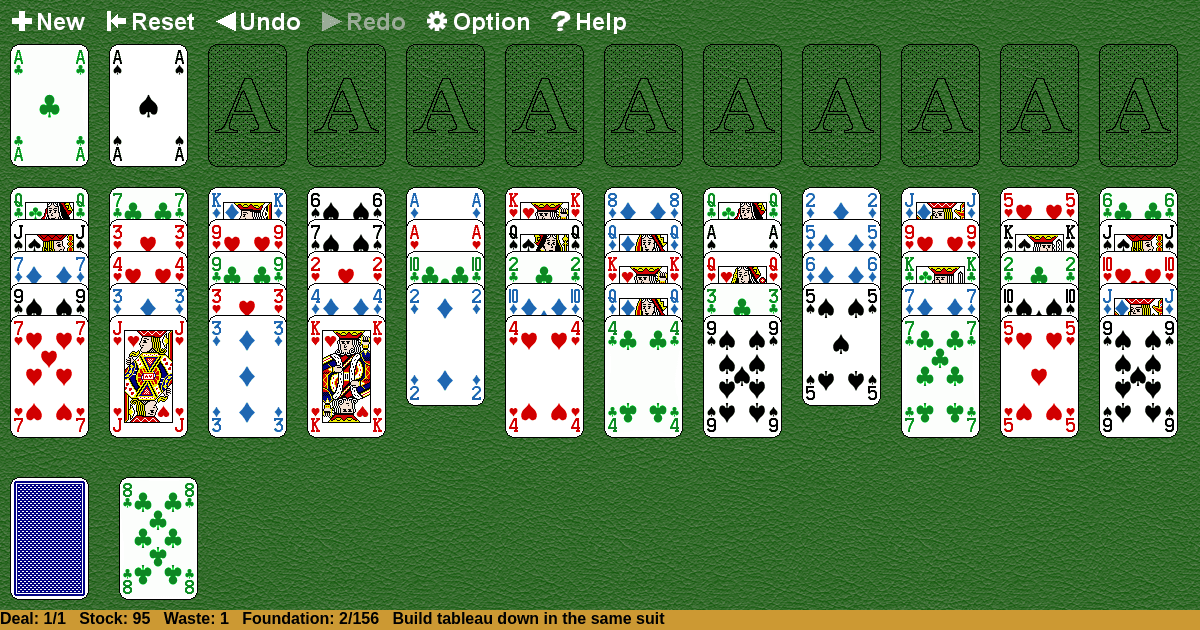Malmaison
Home |
How to play |
FAQ |
About
How to play Malmaison?
Game Objective:
The primary goal in Malmaison Solitaire is to move all 208 cards (from four standard 52-card decks) to the sixteen foundation piles, building each foundation up in suit from Ace to King.
Setup & Layout:
- Deck: Four standard 52-card decks are used (totaling 208 cards).
- Tableau: There are ten tableau piles. Each tableau pile is dealt eight cards, all face-up, at the start of the game.
- Foundations: There are sixteen foundation piles. All are empty at the start, to be built up by suit from Ace to King.
- Stock: The remaining cards after dealing the tableau are placed face-down as the stock.
- Waste: There is one waste pile, which starts empty. Cards are dealt from the stock to the waste, face-up, one at a time.
Key Play Areas Defined:
- Tableau: The main area where cards are temporarily arranged and manipulated.
- Foundations: The destination piles for each suit, built from Ace to King.
- Stock: The draw pile, face-down.
- Waste: The discard pile, face-up; only the top card is accessible.
Malmaison Solitaire Rules:
Card Movements and Interactions:
- Foundations:
- Only an Ace may be moved to an empty foundation pile.
- Foundations are built up by suit (e.g., 2♠ on Ace♠, 3♠ on 2♠, etc.), up to King.
- Once a card is placed on a foundation, it cannot be removed.
- Tableau:
- Tableau piles are built down by suit (e.g., 10♠ on J♠).
- Sequences of cards built down by suit can be moved together as a group.
- Any card or valid sequence can be moved to an empty tableau pile.
- Stock and Waste:
- The stock is dealt one card at a time to the waste pile, face-up.
- Only the top card of the waste is available for play to either the tableau or the foundations.
- There are no redeals; once the stock is exhausted, no further cards can be drawn.
Gameplay:
- Initial Moves:
- Examine the tableau for possible moves, building down by suit or moving cards to the foundations if possible.
- Move sequences of cards within the tableau, provided they are in descending order and of the same suit.
- Move any Ace to an empty foundation pile.
- Stock and Waste:
- When no further moves are available in the tableau, deal one card from the stock to the waste pile.
- Play the top card of the waste to either the tableau (if it fits the building rules) or the foundations.
- Filling Spaces:
- Any card or valid sequence may be moved to fill an empty tableau pile.
- Sequence of Play:
- Continue moving cards between tableau, foundations, and waste as permitted.
- When the stock is depleted and no more moves are available, the game ends.
- No Redeals:
- Once the stock is empty, there is no reshuffling or redealing.
Winning & Losing Conditions:
- Winning: The game is won when all 208 cards are moved to the sixteen foundation piles, each built up by suit from Ace to King.
- Losing: The game is lost if no further legal moves are possible and not all cards have been moved to the foundations (i.e., cards remain in the tableau, waste, or stock).
Special Rules & Edge Cases:
- Filling Empty Tableau Piles: Any card or valid in-suit descending sequence may be moved to an empty tableau pile.
- Moving Sequences: Only sequences of cards in strict descending order and of the same suit may be moved together as a group within the tableau.
- Stock Limitations: There is only one pass through the stock; no redeals are allowed.
- Waste Pile: Only the top card of the waste pile is available for play; cards beneath cannot be accessed until the top is moved.
- No Removal from Foundations: Once a card is placed on a foundation, it cannot be moved back to the tableau or waste.
Edge Case Example: If all tableau piles are empty, but only non-sequential or mixed-suit cards remain in the waste or stock, no valid moves can be made, resulting in a loss.
Summary of Unique Features:
- Uses four decks and sixteen foundations.
- Tableau builds down by suit; sequences can be moved if in-suit.
- Any card or sequence can fill tableau spaces.
- Only one pass through the stock; no redeals.
- High difficulty and low win rate due to strict movement rules and large deck size.

Solitaire Collection
About Malmaison
Rate (Malmaison)
4.7 / 5
1,916 votes



























































